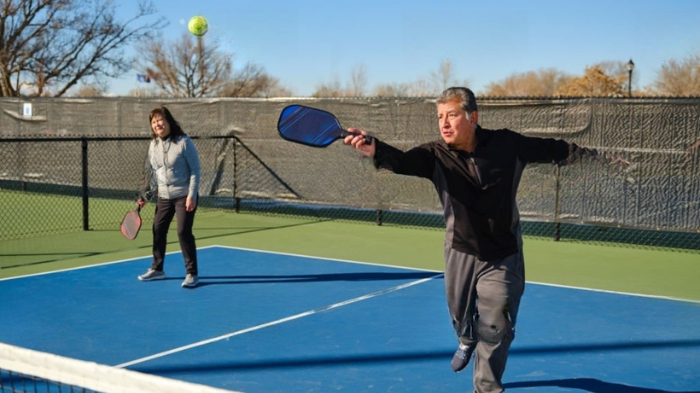Adding texture to your pickleball paddle can significantly enhance your game by improving grip, spin, shot accuracy, and overall control. In this blog post, we are going to explain why it is important to add texture to the pickleball paddle, drawbacks of adding texture to the pickleball paddle, various ways for adding texture to the pickleball paddle, factors to take into account when adding texture to the pickleball paddle, and a step-by-step guide on how to add texture to a pickleball paddle.
Furthermore, this blog will cover essential information on avoiding common mistakes while adding texture to your pickleball paddles. We will also discuss the safety precautions that you should take during the process and provide helpful tips for maintaining and caring for your newly textured pickleball paddles. Let’s start this blog.
Why Adding Textures to Your Pickleball Paddle Is Important?
Adding textures to a pickleball paddle can provide numerous advantages for players. Here are several key reasons highlighting the importance of adding textures to your pickleball paddle:
Enhanced Grip: Textured surfaces on a pickleball paddle provide improved grip, allowing players to have better control over their shots. Adding textures to a pickleball paddle creates a rough surface that enhances the paddle’s grip on your hand. This reduces the risk of the paddle slipping while you play. This is especially crucial when playing in humid conditions or when the player’s hands become sweaty.
Increased Spin: Having textured surfaces on pickleball paddles can increase the amount of spin you can put on the ball. When the paddle makes contact with the ball, the texture creates an additional surface area and increases the grip on the ball. This enhanced grip allows players to generate more spin and have better control over the direction and positioning of their shots, resulting in enhanced effectiveness.
Better Shot Accuracy: The enhanced grip provided by textured paddles gives players better shot accuracy. By having better control over the paddle, players can execute shots more precisely, increasing their ability to hit the ball exactly where they want it to go.
Consistent Feel: When pickleball paddles have textured surfaces, it enhances the gameplay experience by providing reliability and predictability. The texture present on pickleball paddles aids players in developing a deeper sense of familiarity and comfort with their equipment, enabling them to anticipate the ball’s behavior upon impact. This consistent and predictable response empowers players to refine their technique and make confident and precise adjustments to their shots.

Improved Power And Control Balance: A harmonious combination of power and control is achieved by incorporating textures onto pickleball paddles. While a smooth paddle surface may provide additional power, it can sometimes impede shot control. Conversely, textures facilitate better control while ensuring an adequate power output. This results in a versatile paddle that can seamlessly adapt to diverse playing styles and various game scenarios.
It’s worth mentioning that the amount of texture on a paddle can differ. Specific paddles may feature more noticeable textures, while others may have a more subtle texture. The selection of texture largely relies on individual preferences and playing style.
Different Ways for Texturizing Pickleball Paddles
There are several methods for texturizing pickleball paddles. Here are a few common ways:
Surface Roughening: One method is to roughen the surface of the paddle using a sandpaper, a file, or a rough-grit sanding sponge. By lightly sanding or filing the paddle’s surface, you can create small grooves or scratches that can provide texture and improve grip.
Perforations Or Holes: Some players prefer to add texture by drilling small holes or perforations into the paddle’s surface. These holes can be strategically placed to enhance grip and provide a unique texture.
Overgrips Or Tapes: Another popular approach is to apply overgrips or textured tapes to the handle of the pickleball paddle. These grips or tapes often have built-in textures or patterns that help to improve grip and control.
Grip Enhancers: There are specialized grip enhancers available in the market that can be applied to the paddle handle. These products come in the form of sprays, gels, or adhesive films and are designed to add texture and improve grip.
Manufacturer Textured Paddles: Certain paddle manufacturers provide pickleball paddles that come with a pre-textured surface. These paddles are manufactured with the texture already incorporated into the surface during the production process. As a result, they are ready to use without the need for any additional texturizing methods.
It is important to note that altering the pickleball paddle texture may affect its warranty or compliance with tournament regulations. Always check the rules and guidelines of your pickleball organization before making any modifications to your pickleball paddle.
Factors To Consider When Adding Texture To Your Pickleball Paddle
When adding texture to your pickleball paddle, there are several factors to consider, which are given below:
Personal Preference: When texturizing your pickleball paddle, consider your playing style and the texture that suits you best. Some players prefer a rough texture for a strong grip, while others prefer a smoother texture that doesn’t impact their strokes. Find a texture that matches your comfort level and playing preferences.
Grip Level: Decide how much grip you want from the texture. A noticeable texture will give you a stronger grip, which can be helpful for better control or when playing in humid conditions. However, be aware that a highly rough texture might cause discomfort or excessive wear on your hand over time.
Playing Conditions: Think about the usual playing conditions you experience. If you frequently play in humid or wet environments, a textured surface can be helpful in preventing your paddle from slipping and ensuring a firm grip. The added texture will assist in maintaining control even when conditions are moist or slippery.
Rules And Regulations: Ensure that any modifications you make to your paddle’s texture comply with the rules and regulations set by your pickleball organization or tournaments. Some organizations have restrictions on the extent or type of texture allowed on paddles.
Durability: Evaluate the durability of the texture you are considering. Ensure that the texture you choose is durable enough to withstand the demands of gameplay without wearing off too quickly. Long-lasting and durable textures will provide a consistent performance over time.
Reversibility: Think about whether you want the texture to be permanent or removable. Keep in mind that certain methods of adding texture to your paddle are permanent and cannot be undone, while others, like using overgrips or textured tapes, can be easily removed or replaced if desired.
Testing And Experimentation: Before making a final decision, it is beneficial to experiment with various textures and try them out to see which one suits you the best. Borrow paddles from friends or try out demo paddles with varying textures to see which one is suitable for you.
Remember that modifying your paddle’s texture may impact its warranty or eligibility for certain competitions. Always check the guidelines and regulations to ensure compliance before making any changes.
Steps for Adding Texture to the Pickleball Paddles
Here is a step-by-step guide on how to add texture to a pickleball paddle:
Step 1 – Gather Materials: Collect the necessary materials, including sandpaper, a file, a clean cloth, and any desired grip enhancers or textured tapes.
Step 2 – Clean The Paddle: Before starting, it is important to ensure that the paddle’s surface is thoroughly clean and devoid of any dirt or debris. Take a slightly damp cloth or a brush and gently eliminate any dirt or particles from the surface, being cautious not to damage the paddle.
Step 3 – Choose The Texture Method: Choose a suitable method to add texture to the paddle. Options include roughening the surface, applying grip enhancers, or utilizing textured tapes. Here are the options for adding texture to the pickleball paddles:
- Roughening The Surface:
- Select either a sandpaper with a fine texture or a file as the tool for the job.
- With the help of fine-grit sandpaper or a similar tool, gently rub or scrape the paddle’s surface in a consistent pattern, using light pressure. Keep moving the tool in one direction to create small grooves or scratches on the surface.
- Be cautious not to excessively roughen the paddle, as it may affect its performance.
- Once you finish roughening, clean the paddle again to eliminate any debris resulting from the process.
- Applying Grip Enhancers Or Textured Tapes:
- Make sure to carefully read and adhere to the instructions provided by the manufacturer for the selected grip enhancer or textured tape.
- Carefully follow the instructions to properly prepare the grip enhancer or tape before applying it.
- Apply the grip enhancer or tape to the handle of the paddle, ensuring that it covers the surface evenly and attaches securely.
- If using textured tape, flatten any bubbles or wrinkles to achieve a tidy and seamless application.

Step 4 – Test And Adjust: After adding the texture, try playing with the paddle to assess how the texture feels and its effects on your grip and control. If necessary, make adjustments and experiment with different textures until you find the one that best matches your preferences.
Remember to adhere to any rules and regulations set by your pickleball organization or tournaments regarding paddle modifications.
Common Mistakes to Avoid When Adding Texture to the Pickleball Paddle
When adding texture to your pickleball paddle, it is important to avoid common mistakes that can affect the outcome. Here are some mistakes to watch out for:
Excessive Roughening: Avoid roughening the paddle’s surface too aggressively. Overdoing it can impact the paddle’s performance and compromise its integrity.
Inconsistent Texture: Ensure that the texture you create is consistent across the entire paddle surface. Inconsistent texture may result in uneven grip and control.
Poor Surface Preparation: Neglecting to clean the paddle’s surface properly before adding texture can lead to inadequate adhesion or uneven application of grip enhancers or textured tapes.
Improper Application: Always make sure to carefully read and follow the instructions provided by the manufacturer when applying grip enhancers or textured tapes. Incorrect application of grip enhancers or textured tapes can result in an undesirable texture or improper attachment, negatively impacting your overall paddle experience.
Ignoring Personal Preference: Consider your own playing style and preferences when choosing a texture. It is important not to blindly follow trends or recommendations without considering what feels comfortable and enhances your gameplay.
Not Testing And Adjusting: It is crucial to test the paddle after adding texture to evaluate its impact on grip and control. If the texture does not meet your expectations, make necessary adjustments or try different textures until you find the one that suits you the best.
By avoiding these common mistakes, you can enhance your paddle’s texture effectively and improve your overall playing experience.
Safety Measures to Consider When Adding Texture to Your Pickleball Paddle
When adding texture to your pickleball paddle, it is essential to prioritize safety. Here are some important safety measures to consider:
Protect Your Hands: Wear protective gloves or use hand tools when roughening the paddle’s surface to avoid any potential injuries.
Work In A Well-Ventilated Area: Ensure good airflow when using adhesive products or chemicals like grip enhancers or textured tapes. To minimize your exposure to fumes or odors, it is recommended to either open windows or work in a well-ventilated space. This will allow for proper airflow and help to reduce any potential inhalation of harmful substances.
Follow Manufacturer’s Instructions: Adhere to the instructions provided by the manufacturer of grip enhancers or textured tapes to ensure safe and proper application.
Use Safety Equipment: When necessary, use safety goggles or masks to protect your eyes and respiratory system from dust, particles, or fumes.
Avoid Overexertion: Take breaks as needed and avoid excessive physical strain during the texturing process to prevent fatigue or injury.
Proper Disposal: Once you have completed using sandpaper or have adhesive remnants to discard, it is crucial to comply with the local regulations and environmental guidelines for their appropriate disposal. This responsible approach guarantees that these materials are discarded in an environmentally-friendly and conscientious manner.
Read Warning Labels: Be sure to read and understand any warning labels or cautionary information on the products you are using.
By following these safety measures, you can minimize the risk of accidents or injuries while adding texture to your pickleball paddle. Remember to prioritize your well-being throughout the process.
Disadvantages of Adding Texture to Your Pickleball Paddle
Adding texture to a pickleball paddle has certain disadvantages. Here are a few potential drawbacks to consider:
Reduced Durability: The presence of texture on a pickleball paddle can render the surface more prone to wear and tear. Including texture on the paddle can lead to accelerated deterioration compared to a smooth surface, ultimately diminishing the lifespan of the paddle. Consequently, players may need to replace the paddle more frequently, incurring additional costs.
Altered Ball Contact: The texture on the paddle surface can impact the contact between the ball and the paddle. While certain players may find the enhanced grip and control provided by textured surfaces advantageous, others may experience changes in the ball’s trajectory or spin that doesn’t align with their playing style. Adapting to the new tactile sensation and responsiveness of a textured pickleball paddle may require adjustment.
Increased Weight: The process of adding texture to a paddle can add weight to the overall design. The additional material required for texturing can make the paddle heavier, potentially affecting your swing speed and maneuverability on the court. This can be a disadvantage for players who prioritize a lightweight paddle for quick reactions and agility.
Restricted Grip Options: Some players prefer to have the freedom to adjust their grip on the paddle during play. The texture on the surface can limit grip versatility, as the textured patterns may limit the positions where your hand can comfortably hold the paddle. This can reduce your ability to adjust the quick grip for different shots and playing situations.
Potential Rule Limitations: Depending on the pickleball organization or league you participate in, there may be specific regulations regarding paddle surface texture. Certain organizations may impose restrictions on the quantity or specific type of texture permitted on a paddle, and in some cases, they may prohibit the use of textured surfaces entirely. Before adding texture to your paddle, you must check the rules and guidelines of your particular playing environment.
How to Maintain and Care For Your Newly Textured Pickleball Paddle?
To ensure the longevity and optimal performance of your newly textured pickleball paddle, here are some maintenance and care tips to follow:
Clean The Paddle Regularly: After you finish playing pickleball, take a damp cloth and gently wipe the paddle to remove any dirt, sweat, or debris that might have built up on the textured surface. It is important to avoid using strong chemicals or rough cleaners that could harm the texture or the materials of the paddle. Stick to gentle cleaning methods to keep your paddle in good shape.

Avoid Excessive Moisture Exposure: While some texture patterns are designed to enhance grip even when the paddle is wet, it is generally advisable to minimize prolonged exposure to moisture. Moisture can seep into the textured surface, potentially affecting its integrity and causing premature deterioration. If the paddle becomes wet, gently dry it off with a towel.
Store The Paddle Properly: When not in use, store your textured paddle in a cool, dry place. Excessive heat or humidity can negatively impact the texture and materials of the paddle. Consider using a protective cover or case to shield the paddle from accidental damage and to prevent exposure to excessive moisture or sunlight.
Avoid Rough Playing Surfaces: While textured paddles are designed to improve grip, it is essential to avoid using them on rough playing surfaces like gritty or abrasive courts. These surfaces can cause the texture of the paddle to degrade faster over time. To protect the paddle’s texture, it is advisable to play on smooth and less abrasive pickleball courts whenever possible.
Regularly Inspect The Paddle: It is essential to regularly examine your paddle for any indications of damage, such as cracks, chips, or the texture peeling off. If you encounter any issues, it is crucial to address them promptly to prevent additional harm. Based on the extent of the damage, you may need to consider repairing the paddle or purchasing a new one. By taking proactive measures, you can ensure that the paddle maintains its performance and durability over time.
Follow Manufacturer Guidelines: Manufacturers typically provide specific care instructions for each paddle. It is essential to review and adhere to these guidelines to ensure proper maintenance and care. Manufacturer recommendations may vary based on your paddle’s specific materials and construction.
By following these maintenance and care practices, you can extend the lifespan of your newly textured pickleball paddle and continue to enjoy its enhanced grip and performance for a longer duration.
FAQs
Adding texture to your paddle is not mandatory, but it can offer several benefits, such as enhanced grip, increased spin, and better shot accuracy. It ultimately depends on your personal preference and playing style.
Pickleball paddle texture refers to the intentional alterations or specific design features on the paddle’s surface. These changes directly impact how the paddle interacts with the ball during a pickleball game.
It depends on the texture method you choose. Some methods, like using grip enhancers or textured tapes, can be reversed by removing the added materials. However, other methods, like roughening the surface, may be irreversible. Consider the level of reversibility before deciding on a texture method for your pickleball paddle.
Yes, you can add texture to a pickleball paddle that already comes with a factory texture. However, it is important to consider how the additional texture will interact with the existing texture, ensuring that it complements your personal preferences and playing style.
Conclusion
It is important to add texture to the pickleball paddle as it enhances the grip, increases the spin, helps to execute the shots through better shot accuracy, improves the balanced power and control, and enhances the reliable pickleball playing experience of the players. There are different ways to add texture to your pickleball paddle like roughening the surface of the pickleball paddle, making holes or perforations on the paddle’s surface, applying overgrips or tapes and grip enhancers on the paddle’s handle, and using the manufactured textured pickleball paddle.
Consider the factors like personal preference, grip level, playing conditions, rules & regulations, durability, reversibility, and testing & experimentation when adding texture to your pickleball paddle. Follow the steps discussed above on how to add texture to a pickleball paddle by taking some safety measures. Avoid common mistakes like aggressive roughening of the pickleball paddle’s surface, improper cleaning of the paddle’s surface, improper use of grip enhancers or textured tapes, etc., when adding texture to the pickleball paddle.
It is recommended to maintain and take care of your newly textured pickleball paddles for their optimal performance while taking them with you on the court. After writing this blog, we hope you will be able to add texture to your pickleball paddle, test your paddle after texture addition, and take good care of your textured pickleball paddle.



